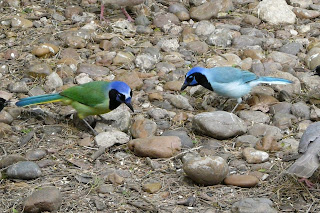 |
| Green Jay "blue-variant". Courtesy of A. Simpson |
In case you still prefer some blue on your jay, the Green Jay does not
disappoint: the crown and nape are bright blue.
Add some yellow-green to the bellies, and a black bib, eye line, and
throat and you've created a Green Jay.
They seem very colorful but when viewed in their native semi-tropical
habitat, they blend in amazingly well with the dappled sunshine and shade. Males, females, and immatures look identical.
 |
| Green Jay and a "blue-variant". Courtesy of A. Simpson. |
A few years ago, the Atascosa refuge had a very special jay. Called the "blue variant" of the Green
Jay", it was missing its yellow pigmentation and instead of being bright
green, was a dull gray-blue. When it
stood next to a regular jay, the difference was stunning. It was famous and highly photographed until
it disappeared, presumably predated.
Interestingly, the Green Jay is the only common jay species in the Rio
Grande Valley. Nowhere else in the US or
Canada can you find these birds; there are also populations in Mexico and South
America. The South Texas subspecies are
colored somewhat differently from their South American relations, which are
sometimes called Inca Jays.
 |
| Green Jays feeding. Courtesy of A. Simpson. |
Like other members of the Corvidae family, which includes jays, ravens, and
crows, they are loud, aggressive, and curious birds. The dinner table certainly never suffers from
lack of conversation while the Green Jays are feeding! A common spectacle, and one that proves their
courage, is to see one or more perched atop a javelina, enjoying a free ride. Studies have shown that Corvids are some of
the most intelligent birds. Green Jays
are no exception to this and have been seen using sticks to poke insects out of
tree bark.
Groups of Green Jays are called bands, parties, or scolds. They are mostly family groups with the young
from the previous year help out with this year's chicks. Once the chicks are two years old, they are
forced to leave and start a family of their own.
 |
| Green Jay perched on a Javelina. Courtesy of A. Simpson |
Green Jays are some of the most interesting birds to watch, especially when
they cock their heads at you inquiringly.
Their beautiful plumage and loud, aggressive behavior provide plenty of
entertainment. If you've never had been
able to view these birds in action, I hope you get the chance to someday. They may not be blue, but they certainly are
amazing birds!
